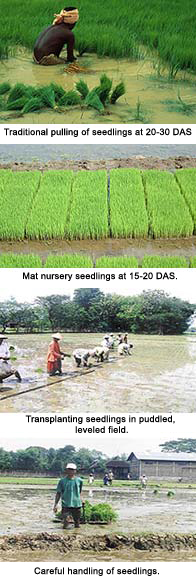Manual transplanting
 What is rice transplanting?
What is rice transplanting?
Transplanting is the most common and elaborative method of crop establishment for rice in Asia. Rice seedlings grown in a nursery are pulled and transplanted into puddled and leveled fields 15 to 40 days after seeding (DAS). Rice seedlings can either be transplanted manually or by machine. This is done in order to get higher yields and less weeding. Broadcasting of seedlings is also practiced in some parts of China.
What is manual transplanting?
Manual transplanting does not require costly machines and is most suited for labor-surplus areas and for small rice fields. Manual transplanting can be done in fields with less than optimal leveling and with varying water levels. Seedlings are raised in a wet, dry, or modified mat nursery. Proper nursery management will produce healthy and vigorous seedlings.
Why transplant rice?
Transplanting ensures a uniform plant stand and gives the rice crop a head start over emerging weeds. Further, seedlings are established even if the field is not leveled adequately and has variable water levels. Transplanting may also allow crop intensification as the crop is in the main field for less time.
How to transplant rice manually?
- Pull out the seedlings at an average of 15 to 30 days after seeding (DAS) from nurseries and transport them to the main field. Traditional varieties can often be transplanted later than modern varieties with little effect on yield.
- In a modified mat nursery, seedlings are ready for transplanting at 15–20 DAS and seedling mats are transported into the main field.
- Transplant the seedlings soon after pulling from the nursery in a puddled, and leveled field (any delay will lead to slow revival or even death of some seedlings).
- Transplant 2–3 seedlings per hill at shallow depth at optimum spacing (20 cm x 20 cm or 22.5 cm x 22.5 cm).
- Handle seedlings carefully to ensure their fast revival and rapid growth after transplanting.
Limitations:
- Transplanting is tedious and time-consuming (up to 30 person-days ha-1).
- Planting laborers can suffer from back problems (health risk).
- Difficult to get enough labor at peak periods to plant on time.
- Difficult to maintain optimum spacing and uniform plant density, especially with random transplanting and contract labor.
- Low plant density with contract transplanting on area basis lowers yields.
- Risk, in rainfed areas, that seedlings (especially of modern varieties) may get too old before rain falls and the field is ready to be planted.